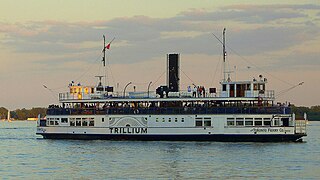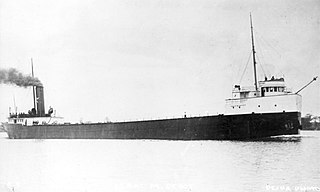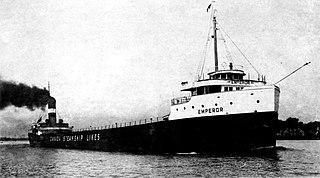Related Research Articles

SS Edmund Fitzgerald was an American Great Lakes freighter that sank in Lake Superior during a storm on November 10, 1975, with the loss of the entire crew of 29 men. When launched on June 7, 1958, she was the largest ship on North America's Great Lakes, and she remains the largest to have sunk there. She was located in deep water on November 14, 1975, by a U.S. Navy aircraft detecting magnetic anomalies, and found soon afterwards to be in two large pieces.

Combermere is a village along the Madawaska River in south-eastern Ontario, Canada. It is part of Township of Madawaska Valley. It is named after Sir Stapleton Cotton, Viscount Combermere (1773-1865).

The SS Regina was a cargo ship built for the Merchant Mutual Line and home ported in Montreal, Quebec. Named after Regina, Saskatchewan, Regina had a tonnage of 1,956 gross register tons (GRT) and a crew of 32.

HMS Ontario was a British warship that sank in a storm in Lake Ontario on 31 October 1780, during the American Revolutionary War. She was a 22-gun snow, and, at 80 feet (24 m) in length, the largest British warship on the Great Lakes at the time. The shipwreck was discovered in 2008. Ontario was found largely intact and very well preserved in the cold water. The wreck discoverers asserted that "the 80-foot sloop of war is the oldest shipwreck and the only fully intact British warship ever found in the Great Lakes."

The Cove Island Light, at Gig Point on the island, is located in Fathom Five National Marine Park, but is not part of the Park. It is situated on the Bruce Peninsula, Ontario, Canada. It has been a navigational aid in the narrow channel between Lake Huron and Georgian Bay since 30 October 1858. It was the first of six stone Imperial Towers to be completed; all were illuminated by 1859. Most other lighthouses of the era were built of brick, wood, iron or concrete.
Kamaniskeg Lake is a lake in the municipalities of Hastings Highlands, Hastings County, and Madawaska Valley, Renfrew County, in Southern Ontario, Canada. It is part of the Ottawa River drainage basin and is located in the Madawaska River Valley, with nearby communities of Barry's Bay and Combermere. The lake is known for its simple beauty, with a mixture of forest, and rock and sand beaches.

M/V Kwasind is a passenger ferry built in 1912 for the Royal Canadian Yacht Club, in Toronto, Ontario, Canada. She is 71 feet (22 m) long. She was built by the Polson Iron Works and cost CA$13,000. Her name was taken from Henry Wadsworth Longfellow's poem about Hiawatha, as the yacht club's previous ferry is Hiawatha.

The Ottawa was a tugboat that sank in Lake Superior off the coast of Red Cliff in Russell, Bayfield County, Wisconsin. The wreckage site was added to the National Register of Historic Places in 1992.

Trillium is a side wheeler ferry operated by the City of Toronto Parks, Forestry and Recreation, in Toronto, Ontario, Canada. Now 113 years old, she is one of several Toronto Island ferries operating between the Jack Layton Ferry Terminal at Bay Street and Queens Quay and three landing points on the Toronto Islands. She is the last sidewheel-propelled vessel on the Great Lakes.
Eastcliffe Hall was a Great Lakes bulk carrier which sank in the Saint Lawrence Seaway on the morning of 14 July 1970 with the loss of nine crewmen and family members.
Save Ontario Shipwrecks (SOS) is a Provincial Heritage Organization in Ontario, Canada. SOS is a public charitable organization which operates through Local Chapter Committees supported by a Provincial Board of Directors and Provincial Executive.

SS Isaac M. Scott was an American Great Lakes freighter that sank during the Great Lakes Storm of 1913 in Lake Huron, 6 to 7 miles northeast of Thunder Bay Island, while she was traveling from Cleveland, Ohio, United States to Milwaukee, Wisconsin, United States with a cargo of coal.

SS. Leafield was a Canadian steel-hulled cargo ship built by the Strand Stepway Company in Sunderland, England, in 1892. Originally registered in Newcastle upon Tyne, England, she was sold after about a year to the Algoma Central Steamship Line and brought to Canada, where she operated on the Great Lakes, carrying coal, grain, and iron ore.

SS Choctaw was a steel-hulled American freighter in service between 1892 and 1915, on the Great Lakes of North America. She was a so-called monitor vessel, containing elements of traditional lake freighters and the whaleback ships designed by Alexander McDougall. Choctaw was built in 1892 by the Cleveland Shipbuilding Company in Cleveland, Ohio, and was originally owned by the Lake Superior Iron Company. She was sold to the Cleveland-Cliffs Iron Company in 1894 and spent the rest of her working life with it. On her regular route between Detroit, Escanaba, Marquette, and Cleveland, she carried iron ore downbound, and coal upbound.

Bluebell was a ferry built in Toronto, Ontario, Canada by Polson Iron Works for the Toronto Ferry Company. She was a steam-powered vessel, propelled by side-wheels. She ferried passengers between the Toronto mainland and the Toronto Islands.

SS Russia was an iron-hulled American Great Lakes package freighter that sank in a Lake Huron gale on April 30, 1909, near DeTour Village, Michigan, with all 22 of her crew and one passenger surviving.

SS John Mitchell was a steel-hulled, American lake freighter in service between 1907 and 1911. She was built in 1906 by the Great Lakes Engineering Works in St. Clair, Michigan, for the Cornell Steamship Company of Chicago, Illinois, which was managed by C.W. Elphicke. She entered service in 1907, and had a sister ship named William B. Davock. Throughout her career, John Mitchell carried iron ore and coal. On October 4, 1908, she ran aground at Indiana Harbor, Indiana, while loaded with iron ore.

SS Manasoo was a steel-hulled Canadian passenger and package freighter in service between 1888 and 1928. She was built in 1888 in Port Glasgow, Scotland, by William Hamilton & Company for the Hamilton Steamboat Company of Hamilton, Ontario, who used her as a passenger transport between Hamilton and Toronto, Ontario. Macassa was lengthened in Collingwood, Ontario, in 1905. She was sold twice before being sold to the Owen Sound Transportation Company, Ltd., and was rebuilt and renamed Manasoo; after the sale, she mainly operated between Sault Ste. Marie and Owen Sound, Ontario.

SS Emperor was a steel-hulled Canadian lake freighter in service between 1911 and 1947. She was built between 1910 and April 1911 by the Collingwood Shipbuilding Company in Collingwood, Ontario, for Inland Lines, Ltd., of Midland, Ontario. She entered service on May 3, 1911. Emperor was sold to Canada Steamship Lines of Montreal, Quebec. Under the ownership of Canada Steamship Lines, she carried a wide variety of cargoes, but most frequently iron ore to Point Edward, Ontario, where it would be transported to Hamilton, Ontario, by train. After the opening of the fourth Welland Canal, Emperor carried the ore directly to Hamilton. She was involved in several accidents throughout her career.
References
- ↑ Elliott, Robbins (8 August 1988). Ontario Book of Days. Dundurn. ISBN 9781554883424 – via Google Books.
- ↑ nurun.com. "Remembering the sinking of the Mayflower". Pembroke Daily Observer.